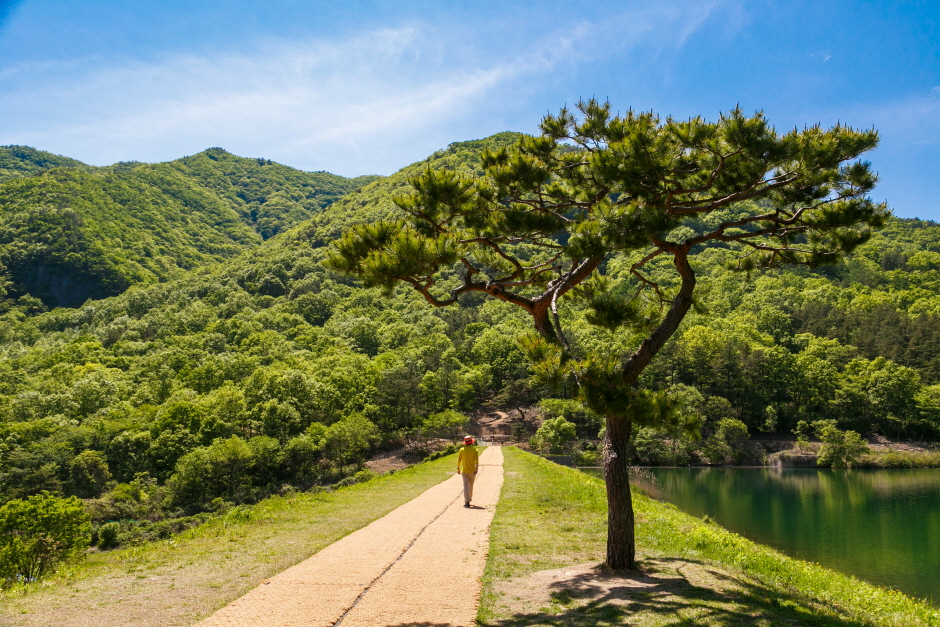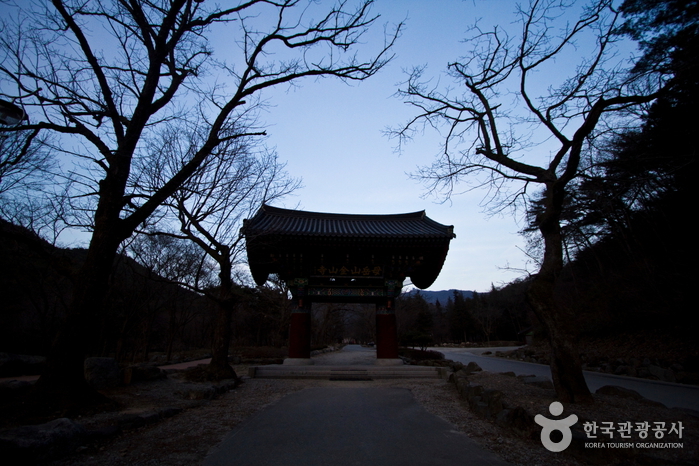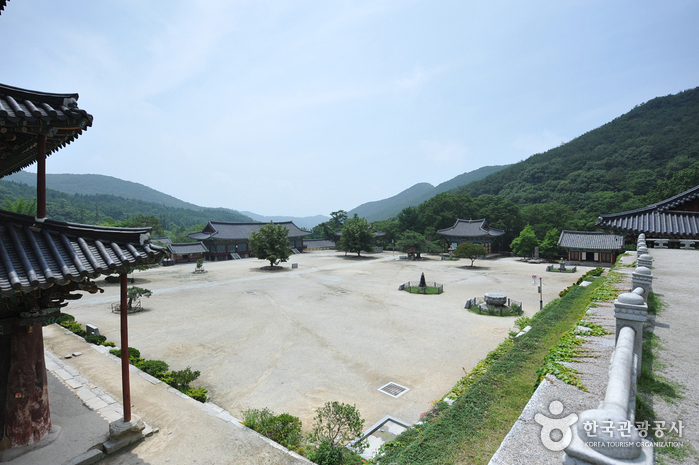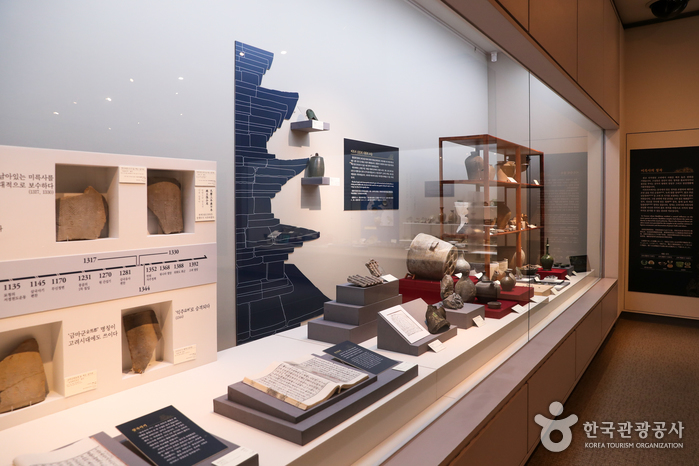Gojonggwan of the Royal Room [Korea Quality] / 왕의지밀 고종관 [한국관광 품질인증/Korea Quality]
12.6Km 2024-04-07
5218-8, Chunhyang-ro, Wansan-gu, Jeonju-si, Jeonbuk-do
+82-63-284-1004
This hanok (traditional Korean house) hotel was opened in 2018. Its location near Jeonju Hanok Village, the central point of Jeonju tourism, gives it excellent access to destinations in Jeonju. As evident from its name, the hotel promises a comfortable stay in a hanok. The hotel complex stands on a plot of land spanning 19,840 m2, containing 11 residential buildings and other facilities.
Each residential building is named after the kings of the Joseon Dynasty. Gojonggwan, named after King Gojong, contains six rooms. The rooms are divided into Gold and Silver Rooms, and are classified into Grade 2, Grade 3, and Grade 5 rooms, all including bathrooms and restrooms in addition to bedrooms. The rooms are furnished to offer the unique aesthetics of hanok in modern comforts. The view of the wooden exposed beams (Gold Room), wooden furniture, and the sunlight from the window wall offer an insight into the beauty of Korea’s traditional residence. All rooms are also equipped with modern comforts such as wireless Internet, TV, refrigerator, and air conditioning.
The hotel also boasts a wide array of facilities, including a spacious parking lot with a capacity of about 150 cars, a hanok cafe serving coffee and traditional tea, and the Convention Center with spaces, such as Daejanggeum Hall and Chungmugong Hall, which offers ideal venues for seminars and other large events. The two hanok restaurants on the premise, Samtaegeuk and Samjogo Restaurant, are designated as COVID-19 Safe Restaurants by the city of Jeonju. It takes only 10 min by car to reach most tourist sites in Jeonju Hanok Village.
Sunjonggwan of the Royal Room [Korea Quality] / 왕의지밀 순종관 [한국관광 품질인증/Korea Quality]
12.7Km 2024-04-07
5218-6, Chunhyang-ro, Wansan-gu, Jeonju-si, Jeonbuk-do
+82-63-284-1004
This hanok (traditional Korean house) hotel is located near Jeonju Hanok Village. The hotel complex stands on a plot of land spanning 19,840 m2, containing 11 residential buildings and other facilities. Modern hanok buildings are built on a line, blending with the surrounding nature to offer a comfortable stay. The name of the hotel is evident in the 11 residential buildings, all named after the kings of the Joseon Dynasty.
Sunjonggwan has six rooms in total. The rooms are divided into Gold and Silver Rooms, and are classified into Grade 2, Grade 3, and Grade 5 rooms, after the grading system used for government officials during the Joseon Period. Gold Rooms are located on the second floor, while the 1st floor is occupied by the Silver Rooms. Each room is furnished with a combination of hanok’s unique charms and modern comfort. Exposed wooden beams fill the room with a gentle scent of wood, while window walls offer an expansive view of the scenery outside.
Restaurants such as Samtaegeuk Restaurant, the site of the hotel’s breakfast offering, and Samjogo Restaurant, a Korean restaurant serving lunch and dinnertime, are designated as COVID-19 Safe Restaurants by the city of Jeonju. The Convention Center, which houses a hanok cafe, also offers a number of different facilities for the guests. It takes only 10 min by car to reach most tourist sites in Jeonju.
Molino de Arroz Saekjang (색장정미소)
13.4Km 2024-04-06
Wonsaekjang-gil 2-15, Wansan-gu, Jeonju-si, Jeonbuk-do
El Molino de Arroz Saekjang, ubicado aproximadamente a 5 minutos en coche desde la Aldea Tradicional de Jeonju, es un café único que antiguamente fue un molino de arroz de más de 70 años. El café expone y vende obras de arte folclórico y tiene todas las comodidades de un café, ideal para contemplar las obras tomando una buena infusión. La mejor zona para tomar fotografías está en el piso de arriba, cuya ambientación es un verdadero viaje en el tiempo.
Happydream [Korea Quality] / 행복드림한옥 [한국관광 품질인증]
13.6Km 2024-10-15
181-21, Bongseoan-gil, Yongjin-eup, Wanju-gun, Jeonbuk-do
+82-10-3677-5339
The Dueok Happy Dream Village Farming Association Corporation runs a hanok-style guesthouse situated in Dueok Happy Dream Village, which is surrounded by high, clean mountains. Also known as Bongseogol, the village is a pleasant farming community located deep in the lush green mountains of Wanju-gun, Jeollabuk-do, and is also well known as one of the eight best propitious sites in Korea – Jongnamsan Mountain on its right and Seobangsan Mountain on its left are said to resemble a phoenix('Bonghwang' in Korean) embracing the village (hence the name of the village is ‘Bongseo’).
Dueok Village was re-born as Dueok Happy Dream Village as part of the rural village revitalization project carried out in Wanju County. The village has jointly run diverse hanok buildings (ranging from about 45 to 150 years old) as hanok-style guesthouses, along with various hands-on programs, since 2010. The Dueok Happy Dream Village Farming Association Corporation now runs the guestrooms and a large experience center, and only accepts groups of guests. The experience center offers education programs on traditional etiquette, and also operates reenactments of the ancient civil service examination. It also offers guests three good meals a day consisting of rural-style healthy food served with wild vegetables and various side dishes at a reasonable price.
The guesthouse comprises tile-roofed houses on both sides set amid a large grassy field against a background of green mountains. The guestrooms feature a simple yet pleasant design and are equipped with ondol (under-the-floor heating) without air-conditioning. The experience center is notable for its ten doors which can be opened by lifting them up toward the ceiling, thereby providing an open view of the beautiful landscape.
Furthermore, the village, which has been designated as a rural experience and recreational village, runs a wide variety of hands-on programs, including a Nature Experience program consisting of a forest tour with a guide, Making a Wish Necklace, Walking on the Myeongdang (propitious site), Rice Farming, Digging Sweet Potatoes, Traditional Folk Games (archery, steel hoop rolling), Rice Cake Pounding, Making Scarecrows, and Making a Kite, among others. It also offers Sori Hakdang and etiquette education programs as a two-day course.
Hotel Moaksan (호텔 모악산)
15.8Km 2025-07-23
104-10, Moaksan-gil, Gui-myeon, Wanju-gun, Jeonbuk-do
Embalse Oseongje (오성제 저수지)
16.1Km 2024-10-15
Daeheung-ri, Soyang-myeon, Wanju-gun, Jeonbuk-do
Ubicado en la zona de Soyang-myeon, distrito de Wanju-gun, provincia de Jeollabuk-do, este embalse está rodeado de un precioso paisaje natural y sus senderos de paseo lo convierten en un espacio ideal para la relajación. En 2019, el grupo BTS visitó el lugar para el programa “2019 BTS SUMMER PACKAGE” y lo hizo famoso como destino turístico.
Parque Provincial del Monte Moaksan (모악산도립공원)
16.1Km 2024-04-07
Moak 15-gil, Geumsan-myeon, Gimje-si, Jeonbuk-do.
Con varios templos budistas en su seno como Geumsansa, Guisinsa, Suwangsa y Daewonsa, el monte Moaksan alcanza 793 metros, ofreciendo una increíble vista panorámica de la zona del sur de Corea. Un punto interesante es que la montaña es el lugar donde se ubica el famoso templo Geumsansa, construido el año 599 con más de 10 tesoros culturales de gran valor. Desde la antigüedad, la montaña se ha considerado un lugar santo para los creyentes en Maitreya (personaje santo en budismo), y en los años 30 y 40 este fue el centro de atención de nuevas religiones, por lo que se crearon numerosos templos pequeños. Las hermosas flores de azalea cubren casi al completo la montaña con su deslumbrante color rojizo y rosado; y los cerezos de primavera también son una atracción única del lugar.
Templo Geumsansa (금산사(김제))
16.2Km 2024-04-07
Moak 15-gil 1, Geumsan-myeon, Gimje-si, Jeonbuk-do.
Situado en la entrada del Parque Provincial del Monte Moaksan, el templo Geumsansa fue construido durante el reinado del rey Beopwang de la época Baekje. Posteriormente pasó por una remodelación realizada por el monje Jinpoyulsa, con la cual mantiene su forma hasta la actualidad. En él se encuentran muchos restos históricos declarados como Tesoros Nacionales, y por conservar en buen estado muchas de sus instalaciones, es considerado como el templo budista más perfecto de la zona sur de Corea. La sala Mireukjeon, hecha con madera, es el único oratorio budista de 3 pisos. Los 3 pisos se encuentran conectados dejando un gran espacio vacío en el centro. En primavera el templo se ve repleto de gente que viene a apreciar el paisaje celestial que crean las flores de cerezos del lugar, y aún en invierno es visitado por los creyentes a rendir adoraciones a la estatua de Buda que se encuentra dentro de la sala Mireukjeon. En la Sala Memorial 1400, que fue construida para celebrar los 1.400 años del templo, se celebran diferentes eventos para los fieles budistas.
Principales tesoros:
Mireukjeon (Tesoro Nacional), Noju (Tesoro Nacional), Seogyeondae (Tesoro Nacional), Hyedeogwangsa Jineungtapbi (Tesoro Nacional), Geumsansa Ocheungseoktap (Tesoro Nacional), Geumsansa Bangdeunggyedan (Tesoro Nacional), Geumsansa Yukgak Dacheungseoktap (Tesoro Nacional), Geumsansa Dangganjiju (Tesoro Nacional), Simwonam Bukgang Samcheungseoktap (Tesoro Nacional), Geumsansa Daejangjeon (Tesoro Nacional), Geumsansa Seokdeung (Tesoro Nacional).
Museo Nacional de Iksan (국립익산박물관)
16.2Km 2024-04-07
Mireuksaji-ro 362, Geumma-myeon, Iksan-si, Jeonbuk-do
El Museo Nacional de Iksan (antiguamente llamado Museo Mireuksaji) fue inaugurado en el año 1997 con el objetivo de conservar y difundir la cultura del reino de Baekje (18 a.c – 660 d.c). Aquí se exponen todas las reliquias descubiertas y excavadas en el solar del templo Mireuksa (Sitio Histórico), el templo más grande correspondiente a la época de Baekje.
En total cuenta con aproximadamente 19.200 reliquias históricas y culturales. Teniendo en consideración la fachada del templo, el museo se ha construido a una altura más baja, cuya construcción arquitectónica, ha tomado la misma forma que la pagoda del templo, lo que ofrece otro espectáculo para apreciar.
Las salas de exposición están clasificadas temáticamente, en la sala central, sala de historia, sala de artes budistas, etc., entre otros, y, entre las reliquias que conserva, se destaca la pagoda de piedra del templo Mireuksa, el más grande de Oriente (Tesoro Nacional), Dangganjiju del templo Mireuksa (dangganjiju es la denominación que se le daba a las columnas de piedra que se encuentran en el interior del templo budista) (Tesoro), etc.
NocWoonJae [Korea Quality] / 녹운재 [한국관광 품질인증]
16.3Km 2024-10-15
472-18, Songgwangsuman-ro Soyang-myeon, Wanju-gun, Jeonbuk-do
+82-10-4450-6565
'As a traditional Korean house with floor area of 99m², Nocwoonjae has been in business since 2014 in Oseong Hanok Village, Wanju-gun, Jeollabuk-do. The name 'Nocwoonjae' means 'a house with a green cloud hanging over it' in Korean. It was named as such because of the green broad-leaved and coniferous trees along the foot of the mountain in the vicinity of the guesthouse. The entrance way is lined with flowers and trees, leading to two Korean houses connected by an open hallway. The guesthouse is owned by two sisters who built this place after staying at many of the popular 'hanok (traditional Korean house)' guesthouses in other parts of the country. It was a dream come true for them, so they did everything in their power to make their place perfect by choosing the building materials themselves, even the tiles. Because the exterior walls are made of red clay and tiles, it's cool in summer and warm in winter. There is also a large wooden floor hall where guests can enjoy the nature. The rooms are decorated with embroidered cotton sheets and antique furniture. Both of the sisters are amateur oriental painters specializing in painting the 'Four Gracious Plants (Plum, Orchid, Chrysanthemum, and Bamboo)', so they even made the lamps with traditional Korean paper with their paintings on them. Indeed, they did everything they could to make this place as pretty as possible.
The two traditional Korean houses named Naunchae and Unachae are built on a natural slope without harming the nature. The two houses are connected by a hallway with windows, so guests can sit on the staircase to enjoy the view outside. The 'Naunchae,' which means 'silky cloud' in Korean, consists of a room, an attic, a kitchen, a hall, and a bathroom. From the attic, you can have a great view of the trees and pine grove through the window. Right behind the house are the strawberry garden and stone walls for the guests to relax. The walls and floor of the room are made of red clay and natural wood with a pleasant natural aroma, which is good for the mind and body. The kitchen walls are made of colorful tiles and wood, with a large window right next to it offering a great view of the pine grove. In the main hall, guests can throw open the large window and lay on the wooden floor to look at the nature and enjoy the breeze.
The 'Unachae,' which means 'beautiful cloud' in Korean, consists of tea room, guestroom, kitchen, hall, and bathroom. It's very similar to the 'Naunchae,' except for the long window next to the kitchen and a table underneath it. The guesthouse sometimes offers special discounts, so be sure to ask about them when booking a room.
There are different types of flowers in the front yard, including cosmos, rose moss, and cockscomb. The sisters also grow corn, sorghum, strawberries, persimmon, jujube, and plum trees there. In the harvest season, guests can pick and try the fruits and vegetables. The sisters also offer a number of experience programs, such as Oriental painting class where you can grind the ink stick and paint the Four Gracious Plants on traditional Korean paper and tea class where you can try the tea made of the persimmon leaves and flowers grown by the owners. Breakfast includes toast, jam, and milk. There is a kitchen, so you can cook whatever you want. Popular tourist destinations in the vicinity of the guesthouse include Songgwangsa Temple and Wibongsa Temple as well as the 60m-high Wibong Falls, one of the Eight Views of Wansan Mountain. Jeonju Hanok Village is a 20-minute ride from the guesthouse.
![Gojonggwan of the Royal Room [Korea Quality] / 왕의지밀 고종관 [한국관광 품질인증/Korea Quality]](http://tong.visitkorea.or.kr/cms/resource/37/2705937_image2_1.jpg)
![Sunjonggwan of the Royal Room [Korea Quality] / 왕의지밀 순종관 [한국관광 품질인증/Korea Quality]](http://tong.visitkorea.or.kr/cms/resource/59/2706059_image2_1.jpg)

![Happydream [Korea Quality] / 행복드림한옥 [한국관광 품질인증]](http://tong.visitkorea.or.kr/cms/resource/23/2576423_image2_1.jpg)




![NocWoonJae [Korea Quality] / 녹운재 [한국관광 품질인증]](http://tong.visitkorea.or.kr/cms/resource/71/2049271_image2_1.jpg)
 Español
Español
 한국어
한국어 English
English 日本語
日本語 中文(简体)
中文(简体) Deutsch
Deutsch Français
Français Русский
Русский